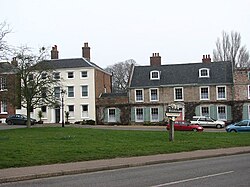Hingham
| Hingham | |
| Norfolk | |
|---|---|
 Georgian houses in Hingham | |
| Location | |
| Grid reference: | 0220&y=3 0210&z=120 TG 022 021 |
| Location: | 52°34’45"N, 0°58’58"E |
| Data | |
| Population: | 2,078 |
| Post town: | Norwich |
| Postcode: | NR9 |
| Local Government | |
| Council: | South Norfolk |
Hingham is a small market town in the heart of rural Norfolk. The civil parish had a population of 2,078 in 944 households as of the 2001 census. Grand architecture surrounds the market place and village green. In the 18th century, when the socialites of high society built houses and took residence in Hingham, it became fashionably known as "Little London".
Hingham is 17 miles from Norwich, Norfolk's county town. While many Hingham people now work in Norwich, commuting by car or bus, the town has maintained a strong base, providing work in a wide range of commercial businesses in its industrial estate on Ironside Way. A major employer in the parish is E F Shingfield & Sons, agricultural suppliers. Several other firms provide a variety of services to agriculture and industry.
The many and varied local shops have the special character of a small market town but are up-to-date in what they provide. Despite the influence and attractions of neighbouring Norwich, an active and independent town life continues to thrive and grow in Hingham.
A fair visits every year, setting up on the historic Fairlands (an area of several triangular greens).
The nearest railway stations are at Wymondham and Attleborough.
History

In the early 17th century, a number of Puritan residents of Hingham, led by Hingham's former vicar Robert Peck and his associate Peter Hobart, emigrated to the Massachusetts Bay Colony, where they founded the town of Hingham. Peck had been censured by religious authorities for his Puritan practices, and his daughter had married the son of another well-known Puritan minister, John Rogers (c.1570–1636).
The parishioners who left Hingham with Peck and Hobart had been so prominent in the community that the town was forced to petition Parliament for help, claiming that it had been devastated by the loss. Amongst their number were Samuel Lincoln (ancestor of President Abraham Lincoln) and Edward Gilman Sr., ancestor of Nicholas Gilman, New Hampshire delegate to the Continental Congress and signatory of the United States Constitution. Memorials to the Gilman family, ancestors of those who went to America, are still visible in St Andrew's Church in Hingham, which also has a bust of Abraham Lincoln on the wall.[1] (Several centuries later, the Gilmans of Hingham supplied two mayors of Norwich.)[2]
Miscellany
In 2000, it was reported that Adrian Semmence, whose family had farmed at Hingham for three generations, was opening a woodland park (to be funded by the sale of 36 square-foot plots, mainly to Americans having connections with Hingham) to commemorate the links between his village and Hingham, Massachusetts.[3]
The Caterham F1 team, previously Team Lotus was based here, but left Norfolk to the old Arrows team factory near Silverstone Circuit. It used to be based in nearby Hethel, but after its bankruptcy in 1994 there wasn't much activity until Lotus was resurrected as an F1 team in 2010.

Outside links
| ("Wikimedia Commons" has material about Hingham) |